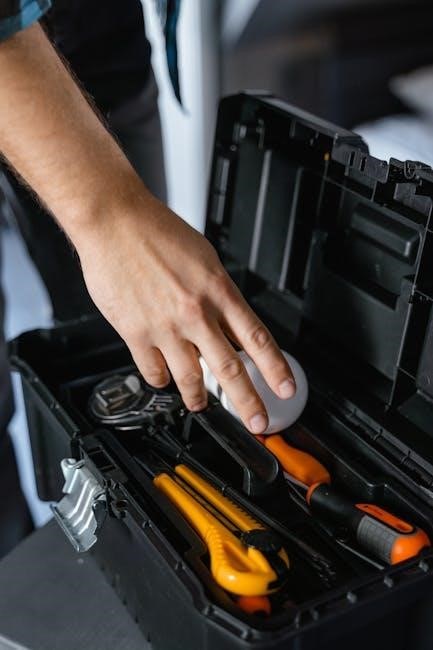Welcome to the Singer Heavy Duty manual, your comprehensive guide to unlocking the full potential of your sewing machine. This manual ensures optimal performance, covering setup, maintenance, and troubleshooting for a seamless sewing experience.
1.1 Overview of the Singer Heavy Duty Sewing Machine
The Singer Heavy Duty sewing machine is a robust, versatile appliance designed for handling heavy-duty sewing tasks with ease. Built to withstand demanding projects, it features 23 stitch patterns, automatic settings, and compatibility with thick fabrics and heavy-duty threads. Its durable construction and user-friendly interface make it ideal for both home sewists and professionals seeking reliable performance for a wide range of sewing needs.
1.2 Importance of the Manual for Optimal Usage
The Singer Heavy Duty manual is essential for maximizing the machine’s potential and ensuring longevity. It provides detailed instructions for setup, operation, and maintenance, helping users avoid common errors. The manual also offers troubleshooting tips and safety guidelines, ensuring safe and efficient usage. By following its guidance, users can achieve professional results while extending the life of their machine. Regular reference to the manual guarantees optimal performance and satisfaction.

Key Features of the Singer Heavy Duty Sewing Machine
The Singer Heavy Duty sewing machine boasts 23 stitch patterns, heavy-duty thread compatibility, and automatic settings for versatility. It handles thick fabrics effortlessly, ensuring durability and precision.
2.1 Stitch Patterns and Customization Options
The Singer Heavy Duty sewing machine offers 23 built-in stitch patterns, including straight, zigzag, and decorative options. Users can customize stitch length and width, adapting to various fabrics and projects. The machine also supports heavy-duty thread, ideal for thick materials, ensuring strong and durable seams. This versatility allows sewists to tackle a wide range of tasks, from heavy-duty fabrics to delicate textiles, with precision and ease.
2.2 Heavy Duty Thread and Fabric Compatibility
The Singer Heavy Duty sewing machine is designed to handle thick and heavy fabrics, including denim, canvas, and upholstery materials. It is compatible with heavy-duty threads, such as carpet thread, ensuring strong and durable seams. Lightweight fabrics like cotton, silk, and muslin can also be sewn with ease by adjusting the stitch length and tension settings. This versatility makes it suitable for a wide range of sewing projects, from home decor to heavy-duty repairs.
2.3 Automatic and Manual Settings for Versatility
The Singer Heavy Duty sewing machine offers a blend of automatic and manual settings, providing versatility for various sewing tasks. Automatic features include preset stitch patterns and a one-step buttonhole, while manual controls allow for precise adjustments in stitch length and tension. This combination ensures that both beginners and experienced sewists can achieve professional results, adapting to different fabrics and projects with ease and accuracy.
Setup and Basic Operations
Unpack and assemble your Singer Heavy Duty machine carefully. Thread the machine and set up the bobbin as instructed. Begin with basic stitching, adjusting tension for smooth operation.
3.1 Unpacking and Initial Assembly
Begin by carefully unpacking your Singer Heavy Duty sewing machine from the box. Ensure all accessories, such as the presser feet and needles, are accounted for. Follow the manual’s step-by-step guide to assemble the machine correctly. Attach any additional parts like the extension table or spool pin. Make sure all components are securely fitted before plugging in the power cord. Proper assembly ensures safety and optimal performance right from the start.
3.2 Threading the Machine and Bobbin Setup
Start by inserting the spool pin into the machine and threading the Singer Heavy Duty sewing machine as illustrated in the manual. Use heavy-duty thread in the upper tension and all-purpose thread in the bobbin for optimal performance. Wind the bobbin evenly, ensuring it’s not overfilled. Insert the bobbin into the bobbin case, pull the thread gently to set the tension, and close the case. Proper threading and bobbin setup are crucial for smooth stitching. Refer to the diagrams in your manual for clarity.
3.3 Basic Stitching and Tension Adjustment
Begin by selecting the desired stitch pattern on your Singer Heavy Duty machine. Start with a straight stitch for basic sewing. Adjust the stitch length and width using the dials provided. For even stitching, ensure the fabric lies flat under the presser foot. If the thread is too tight or loose, tweak the upper or bobbin tension accordingly. Test stitches on scrap fabric to achieve the perfect balance before working on your final project.
Maintenance and Troubleshooting
Regularly clean and oil your Singer Heavy Duty machine to ensure smooth operation. Refer to troubleshooting tips for common issues like thread breakage or uneven stitches.
4.1 Regular Maintenance Tips for Longevity
Regular maintenance ensures your Singer Heavy Duty machine runs smoothly. Clean lint from the bobbin area and feed dogs after each use. Oil the machine periodically to keep parts lubricated. Check the presser foot pressure and adjust if necessary. Use the correct thread and needle sizes to prevent damage. Store the machine in a dry place to avoid rust. Follow these tips to extend the lifespan of your sewing machine.
4.2 Common Issues and Solutions
Common issues with the Singer Heavy Duty machine include thread bunching, uneven stitching, or jammed needles. To resolve these, ensure proper thread tension, use the correct needle size, and maintain even fabric feed. For thread bunching, check the bobbin setup and thread path. If needles jam, inspect for debris and ensure correct needle alignment. Regular lubrication and cleaning can prevent many issues. Refer to the manual for detailed troubleshooting steps to maintain smooth operation.
Advanced Sewing Techniques
Master advanced sewing techniques with the Singer Heavy Duty machine, including working with heavy fabrics, using double needles, and specialized presser feet for professional results.
5.1 Working with Heavy Fabrics and Thick Materials
The Singer Heavy Duty excels with heavy fabrics and thick materials. Use heavy-duty thread in the upper tension and all-purpose thread in the bobbin. Adjust the presser foot pressure by tightening for heavy fabrics and loosening for lighter ones. For thick materials, use specialized needles like size 18 for heavy-duty tasks. Set the stitch length to 3 or 4 for optimal results. This ensures smooth stitching on denim, canvas, or multiple fabric layers.
5.2 Using Double Needles and Specialized Feet
Enhance your sewing experience with double needles and specialized feet. Double needles create parallel stitch lines, perfect for decorative sewing and preventing fabric stretching. Use the Teflon foot for smooth stitching on heavy fabrics like leather, while the walking foot handles thick materials effortlessly. For heavy-duty tasks, attach the edge joining foot to align fabrics perfectly. Always pair heavy-duty needles with compatible threads to ensure durability and professional-grade results.

Safety Precautions
Always follow safety guidelines to prevent accidents. Keep the machine out of children’s reach and supervise them. Use the machine only for its intended purpose and avoid hazards.
6.1 General Safety Guidelines for Operation
Always read the manual thoroughly before using the Singer Heavy Duty sewing machine. Keep children away and supervise them closely. Use the machine only for its intended purpose and avoid operating it near water or in humid environments. Ensure loose clothing or long hair is tied back. Never touch moving parts or use the machine in poor lighting. Keep the work area clean and clear of clutter. Follow all maintenance recommendations and turn off the machine when not in use for safety.
6.2 Child Safety and Supervision
The Singer Heavy Duty sewing machine is not a toy and should be kept out of children’s reach. Always supervise children near the machine and ensure they do not play with any parts. Teach children to respect the machine and never allow them to operate it without close adult supervision. Keep the machine in a safe location and store accessories securely when not in use. Follow these guidelines to ensure a safe environment for everyone. Page 38 and 30 of the manual emphasize these precautions.

Accessories and Compatibility
Explore the range of compatible accessories for your Singer Heavy Duty sewing machine, including presser feet, specialized attachments, and recommended threads and needles for optimal performance.
7.1 Presser Feet and Specialized Attachments
The Singer Heavy Duty sewing machine supports various presser feet and attachments, enhancing versatility. From standard feet to specialized options like zipper, buttonhole, and walking feet, these accessories enable precise control for diverse fabrics and techniques. Additionally, double needles and heavy-duty thread compatibility ensure robust stitching on thick materials, making it ideal for heavy-duty sewing tasks. These attachments expand your creative possibilities and improve efficiency in handling challenging projects.
7.2 Thread and Needle Recommendations
For optimal performance, use heavy-duty thread for thick fabrics and all-purpose thread for lighter materials. Needle sizes 80 to 100 are recommended, depending on fabric weight. Heavy-duty needles (size 12/80 to 18/110) are ideal for dense materials like denim or canvas. Proper thread and needle selection ensures consistent stitching, reduces breakage, and enhances the machine’s versatility for various sewing projects. Always choose high-quality threads and needles to maintain durability and achieve professional results.

Warranty and Support
The Singer Heavy Duty manual includes a detailed warranty section and support information, ensuring users have access to troubleshooting, maintenance tips, and customer service assistance for optimal performance.
8.1 Understanding the Warranty Coverage
The Singer Heavy Duty sewing machine comes with a comprehensive warranty that covers parts and labor for a specified period. This warranty ensures protection against manufacturing defects, providing users with peace of mind. It’s essential to review the warranty terms to understand what is included and any conditions that may void the coverage. Proper maintenance and adherence to guidelines can help maximize warranty benefits and machine longevity.
8.2 Contacting Singer Customer Support
Singer offers comprehensive customer support to assist with any queries or issues. Their support team is available in multiple languages, ensuring accessibility for users worldwide. The official Singer website provides detailed resources, including manuals, troubleshooting guides, and contact information. For specific models like the Singer Heavy Duty 4432, users can download manuals or reach out via phone, email, or online forms. Always have your machine’s model number ready for efficient support.
With the Singer Heavy Duty manual, you’re equipped to master advanced sewing techniques and maintain your machine for years of reliable service and creative satisfaction.
9.1 Maximizing Your Sewing Experience with the Singer Heavy Duty
The Singer Heavy Duty sewing machine is designed to enhance your sewing journey with its robust features and versatility. By following the manual’s guidelines, you can explore various stitch patterns, work with heavy fabrics, and maintain your machine for long-lasting performance. Regular maintenance and proper thread usage ensure optimal results. With this guide, you’ll unlock the full potential of your Singer Heavy Duty, creating professional-quality projects with ease and confidence.